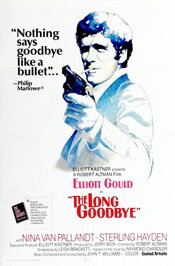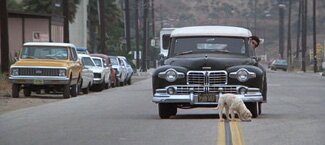 Directed by Robert Altman
Directed by Robert Altman
This is such a Robert Altman movie. You love it and you hate it. It’s wonderful and it’s frustrating.
You can’t help wondering if you’re confused, the film’s confused, or if both of you are.
In the case of The Long Goodbye, you have a movie that everything suggests is film noir but, coming from Altman, it’s as much satirical as anything else and because it is, it isn’t film noir at all.
There is little point in trying to describe the story because, between the Raymond Chandler novel and Robert Altman’s movie, it defies summary because it is so convoluted (or simply confused). In both cases, both the novel and the movie, the story isn’t really the important thing.
Phillip Marlowe is visited by a friend. Marlowe is asked to drive the friend to Mexico, which he does. Upon returning, the friend’s wife is discovered to have been murdered. The friend, missing, is also later reported to be dead. A huge amount of money has vanished, which Marlowe is put on the hook for by a mobster. Eventually the mystery surrounding it all is sorted out, but not without further confusion and violence.

It takes Altman’s movie a long time to get underway because the director is less interested in the plot than he is in the character of Marlowe, played by Elliot Gould. The actor is perfect for the role as interpreted by Altman.
Personally, Gould’s bland, blasé, somewhat slovenly and sleepy-eyed acting style has always irritated me but here it’s exactly what Altman is looking for. As the director says in the accompanying feature on the DVD, Marlowe is a man who has been asleep for twenty years and has awakened to find himself in the early 70s. It was this idea that informed the approach the movie takes.
The movie does eventually get underway but, even when it does, it meanders and only pays passing deference to telling a story. This is fine, given what Altman wants to do, but because it uses the noir genre as a vehicle to parody, and because the satire is generally understated, an audience can’t really get past their expectations of a noir thriller.

This means they expect something much more structured, plot driven and quickly paced. Of course, doing this would make it a different movie than Altman wants to make – in fact, he has no interest in making that kind of movie. But again, because the satire begins with the semblance of a noir film, the audience and the film don’t quite meet. The one expects one thing while the other is doing something altogether different.
Despite this, there are some great scenes in the film and some curious performances (such as Sterling Hayden who is a little over the top but interesting nonetheless). Gould’s Marlowe becomes more interesting in the latter half of the film when he begins to “wake up,” and get more engaged in his surroundings. His dullness in the first half doesn’t quite work however because, though appropriate, there doesn’t appear to be any explanation for it beyond him being a slob.
I think Altman’s clues, such as the California girls living next to Marlowe, aren’t sufficiently in-your-face. It requires a second or third viewing to understand where Altman (and the Marlowe character) are coming from.
For me, I was frustrated by the movie. While not necessarily true for everyone, I simply couldn’t get past my expectations of what this movie appeared to be (noir). And I wasn’t sufficiently perceptive to really pick up on what Altman was doing.

Turning to the DVD — again, it’s love it and hate it. Some of the scenes, especially night scenes, were simply not dark enough in the transfer.
This may have something to do with how the film was shot, though I really don’t know enough about these things to say. But some scenes simply came across as poorly degraded film, or overly saturated in sepia. Other scenes, daylight ones, were perfectly clear and crisp.
As for extras, this is one of the best I’ve come across simply because of the two features. While I would have liked more, both were actually about the film and it’s creation.
In the first, Altman discusses what he was trying to do and you definitely get a better understanding and appreciation for the film because of it. In the second, cinematographer Vilmos Zsigmond discusses some of the technical aspects of the lighting and shooting overall and this also provides great insights. (I was especially interested in what he had to say about contemporary films that are such high contrast, colour saturated films – Hart’s War, for example.)

This is not a movie for anyone steeped in today’s fast paced, quick cut, move-the-story-along quickly approach. It is a good movie on its own terms however, and is definitely worth seeing, particularly if you have an interest in Robert Altman’s body of work.
As mentioned at the beginning, it’s a great, frustrating, not easily labelled movie. It is also one of the best things Elliot Gould has done. (As an irrelevant aside, I would take The Long Goodbye over M*A*S*H any day. But I would also take Gosford Park over The Long Goodbye.)



1 Response